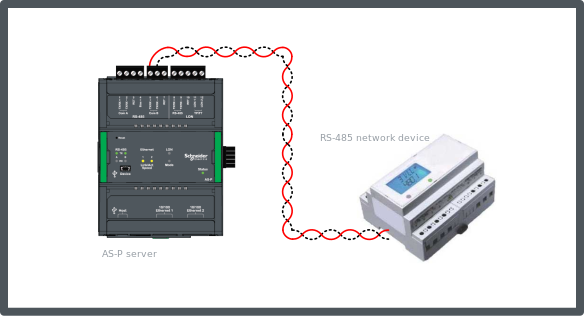
Concept
Generic RS-485 Network Devices
This application note provides recommendations and guidelines for the RS-485 interface port configuration between the automation server and generic RS-485 network devices (Modbus or MS/TP). This information is intended to supplement the instructions you receive with the various RS-485 network devices. The guidelines focus on the arrangement of the electrical interface to the automation server's RS-485 port in regards to biasing, termination, cable selection, cable lengths, and cable routing. The guidelines on maximum unit load (node count) and common mode voltage tolerance are associated with AS-P and AS-B servers.

RS-485 interface between an AS-P server and a generic RS-485 network device
The recommendations listed here pertain to the electrical load characteristics. The node count limits are related to the electrical interface, termination, biasing and cable characteristics. The final node count limit may be lower as a function of individual product configurations, resources or performance limits. Consult with the product reference manuals, installation instructions, and guidelines for the various RS-485 network device products to determine the system configuration and capacity objectives. This information is intended to supplement the existing product documentation. The recommendations here will only maintain or reduce the product documented node capacity (on a single bus) and/or the length of the bus. The various capacities and distances described in the product can frequently operate acceptably. However, some projects may encounter environment and cabling characteristics where a reduction of tolerance presents issues. The intention here is to adjust the configuration recommendations to consider the influences on the network load and cable length with the objective of operating within the margins defined by the TIA-485A standard and the transceiver manufacturers' datasheets.
Worksheet for Configuration of RS-485 Bus with Generic RS-485 Devices
To make appropriate recommendations, it is necessary to first collect some information about the intended configuration. The worksheet contains questions, which identify some specific attributes that affect the proposed configuration. Review the installation guide and manuals for the products to be connected to the RS-485 port on the automation server. Use the product manuals along with your project details to answer the questions in the worksheet.
For more information, see Worksheet for Configuration of RS-485 Bus with Generic RS-485 Devices .
Configuration Selection for Generic RS-485 Network Devices
Use the answers from the worksheet together with these flowcharts to determine the recommended RS-485 bus configuration for your generic RS-485 devices.
For more information, see Configuration Selection for Generic RS-485 Network Devices .
Unit Load Definition, Maximum Network Load and Affects of Excess Unit Load
According to the TIA-485A standard, a single unit load is equivalent to a 12 kohm impedance attached to the + and – data lines (connected to ground or supply). A 1/8UL transceiver would have an impedance of 96 kohm. The TIA-485A defined total network load limit of 32UL is based on a common mode load resistance of 375 ohm connecting both the + and – data lines to ground (or CMV source). The standard requires the RS-485 drivers be capable of driving a network load of 32UL along with a Common-Mode Voltage (CMV) difference of -7 V to +12 V and produce a guaranteed minimum of 1.5 V transmit signal level. Such a full UL load with severe CMV conditions exhausts the maximum drive current of 60 mA provided by all standard RS-485 drivers. The specified minimum of 375 ohm resistance for the common mode load is the resulting resistance seen when 32 transceivers with 12 kohm input impedance are placed in parallel (12,000 / 375 = 32).
For more information, see Unit Load Definition, Maximum Network Load and Affects of Excess Unit Load (MNB and Generic RS-485 Devices) .
Expanded Unit Load with Network of Isolated Devices Only
If the network is comprised exclusively of devices with isolated RS-485 interfaces with the only exception being the automation server, it is recommended that the maximum unit load limit can be stretched higher. It is recommended that a maximum load extension should be 16UL (50% overload) giving a total expanded unit load limit of 48UL. Using a maximum network load of 48UL and subtracting the 24UL for the bias network and the automation server leaves 24UL available for the RS-485 devices. With the example device load of 0.18UL each, it is suggested that the isolated bus arrangement could support the full collection of up to 127 devices.
For more information, see Expanded Unit Load with Network of Isolated Devices Only (MNB and Generic RS-485 Devices) .
Cable Routing
The RS-485 network cable should be routed in a continuous daisy chain bus configuration. There should not be any stub connections, stars or ring configurations. The bussed cable should pass through each node to be connected with no splits or branches in the cable network.
For more information, see Cable Routing .
Cable Selection
This is one of the most important selections having significant impact on the performance and reliability of the RS-485 network being installed. An incorrect cable selection can be difficult and expensive to reverse. The decision should not be made on previous examples of seeing some alternate non-compliant cable work.
For more information, see Cable Selection .
 RS-485 Communications
RS-485 Communications
 Worksheet for Configuration of RS-485 Bus with Generic RS-485 Devices
Worksheet for Configuration of RS-485 Bus with Generic RS-485 Devices
 Configuration Selection for Generic RS-485 Network Devices
Configuration Selection for Generic RS-485 Network Devices
 Unit Load Definition, Maximum Network Load and Affects of Excess Unit Load (MNB and Generic RS-485 Devices)
Unit Load Definition, Maximum Network Load and Affects of Excess Unit Load (MNB and Generic RS-485 Devices)
 Expanded Unit Load with Network of Isolated Devices Only (MNB and Generic RS-485 Devices)
Expanded Unit Load with Network of Isolated Devices Only (MNB and Generic RS-485 Devices)
 Cable Routing
Cable Routing
 Cable Selection
Cable Selection